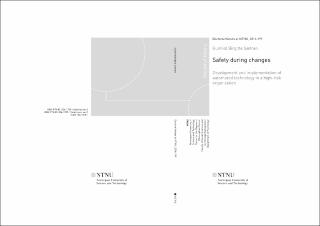Safety during changes: Development and implementation of automated technology in a high-risk organization
Doctoral thesis
Permanent lenke
http://hdl.handle.net/11250/2401699Utgivelsesdato
2016Metadata
Vis full innførselSamlinger
- Institutt for psykologi [3140]
Sammendrag
This thesis aimed to explore safety during changes and more specific, safety in managing development and implementation of automated technology in a high-risk organization. A longitudinal case study of an implementation process of new technology on an offshore oil and gas installation was carried through. In all, 43 interviews, and participative observations offshore and onshore were conducted. Grounded theory was used to analyse the data.
The findings reported in the first paper indicated that according to the readiness to change theory of Armenakis and Harris (2009) the implementation process had been a success as the technology was accepted. However, findings further indicated that the trust from the crew members was too high, according to the theory of high reliability organizations (HRO) (Weick & Sutcliffe, 2007), and that a non-questioning culture contributed to a change process that resulted in a serious unwanted incident.
The second paper found that the development phase of the product could have benefitted from more thoroughly human factors and human reliability analyses. Mishaps that had occurred due to incorrect use of the product were found to partly be because the developers did not sufficiently comprehend who they were developing for. Insufficient human factors analyses was partly the reason why the product ended as more costly than necessary, not as user friendly as requested, and end users having insufficient knowledge on safe usage and potential risks of the technology.
The third paper presented a critical review on traditional change management theories and how they were considered insufficient regarding ensuring safety. The main reason was that the emphasis is on ensuring willingness to change which does not correspond with the emphasis on diversity and trained scepticism, which HRO recommend. The paper presents a model that, based on both theory and practice, gives a step by step guidance on how to conduct changes within organizations with a focus on safety.
The conclusion of the thesis is that HRO and human factors is recommended to be intertwined elements in change processes in high-risk organisations in order to ensure a safest possible change in high risk industries.
Består av
Paper 1: Sætren, Gunhild Birgitte; Laumann, Karin. Effects of trust in high-risk organizations during technological changes. Cognition, Technology & Work 2014 ;Volum 17.(1) s. 131-144 https://doi.org/10.1007/s10111-014-0313-zPaper 2: Sætren, Gunhild Birgitte; Hogenboom, Sandra; Laumann, Karin. A study of a technological development process: Human factors—the forgotten factors?. Cognition, Technology & Work 2016 ;Volum 18.(3) s. 595-611 https://doi.org/10.1007/s10111-016-0379-x also available at http://hdl.handle.net/11250/2434468
Paper 3: Sætren, Gunhild Birgitte; Laumann, Karin. Organizational change management theories and safety. A critical review.. Safety Science Monitor 2017 ;Volum 20.(1)
